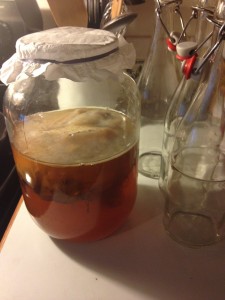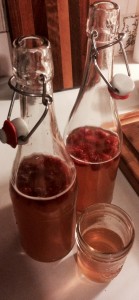Kombucha

A few years ago a friend of mine gave me a piece of her kombucha culture so I could start brewing my own. I made it for a while, but then I decided to stop…I don’t even really remember why, but I’ve missed it ever since.
Wanting to start making it again, I bought myself a dehydrated kombucha culture (known as a SCOBY: Symbiotic Culture Of Bacteria and Yeast, also referred to as a “mushroom” or “mother”), followed the directions to properly rehydrate the SCOBY, waited the agonizing 30 days for rehydration, made my first real batch of kombucha, pulled it out of my pantry to taste test it after seven days of fermentation, and BIG GIANT BUMMER! Mold. Quarter-sized green disks of fur floating on top of the tea. After consulting with my friend (who is also a rep for Culture’s for Health), I was told I should have added vinegar to my first batch in order to keep the ph within the proper range. I had added vinegar to the rehydration batch, but didn’t use it again in my first kombucha batch. You always save some kombucha from each batch to add to the next batch, as that helps keep the ph where it’s supposed to be. Once established, a SCOBY plus some of your previous brew is perfectly capable of keeping the ph of the tea within the desired range (below 4). But before the SCOBY starts doing it’s job, adding vinegar to the rehydration phase and first (maybe even second) brew is necessary. You can use ph strips to measure for proper level.
Sadly, my moldy SCOBY was buried in my compost pile.

SCOBYs aren’t pretty, but if you enjoy drinking kombucha you will love your ugly SCOBY with all your heart.
Thank goodness that not only was I able to get a store credit from Culture’s for Health for my now deceased SCOBY, but I also got a piece of my friend’s own fully functioning SCOBY so I didn’t have to wait as long to quench my kombucha thirst.
Kombucha is fermented tea. A SCOBY is submerged into black or green tea that has had sugar added to it. The SCOBY consumes the sugar, fermenting the tea. The end result is a fizzy, vinegary drink full of beneficial probiotics. Successful kombucha depends on a specific tea/water/sugar ratio.
You can use different types of black or green teas to create different tastes and strengths. I like drinking kombucha plain (poured right out of the brew jar), or making a second ferment by adding something tasty, like raspberries or fruit juice, to a flip top bottle of kombucha and letting it sit on the counter for another day or two.
Unlike water kefir which you have to change out every 24-48 hours, kombucha can go from as little as 7 days, all the way up to 30 days, before you have to make a new batch. The stronger you enjoy your kombucha, the longer you’ll allow it to ferment.
Brewing kombucha is so easy, and it’s really fun to play around with flavors during a second ferment. Bottles of kombucha in the grocery store sell for about $3-5 each, but when you brew at home you really just have to buy tea and sugar. Making a whole gallon may cost you only a couple of dollars.
Culture’s for Health kombucha SCOBYs can be purchased online or at Neighbor’s Market in Vancouver. The CfH website is a great resource for how-to videos and general kombucha information.

